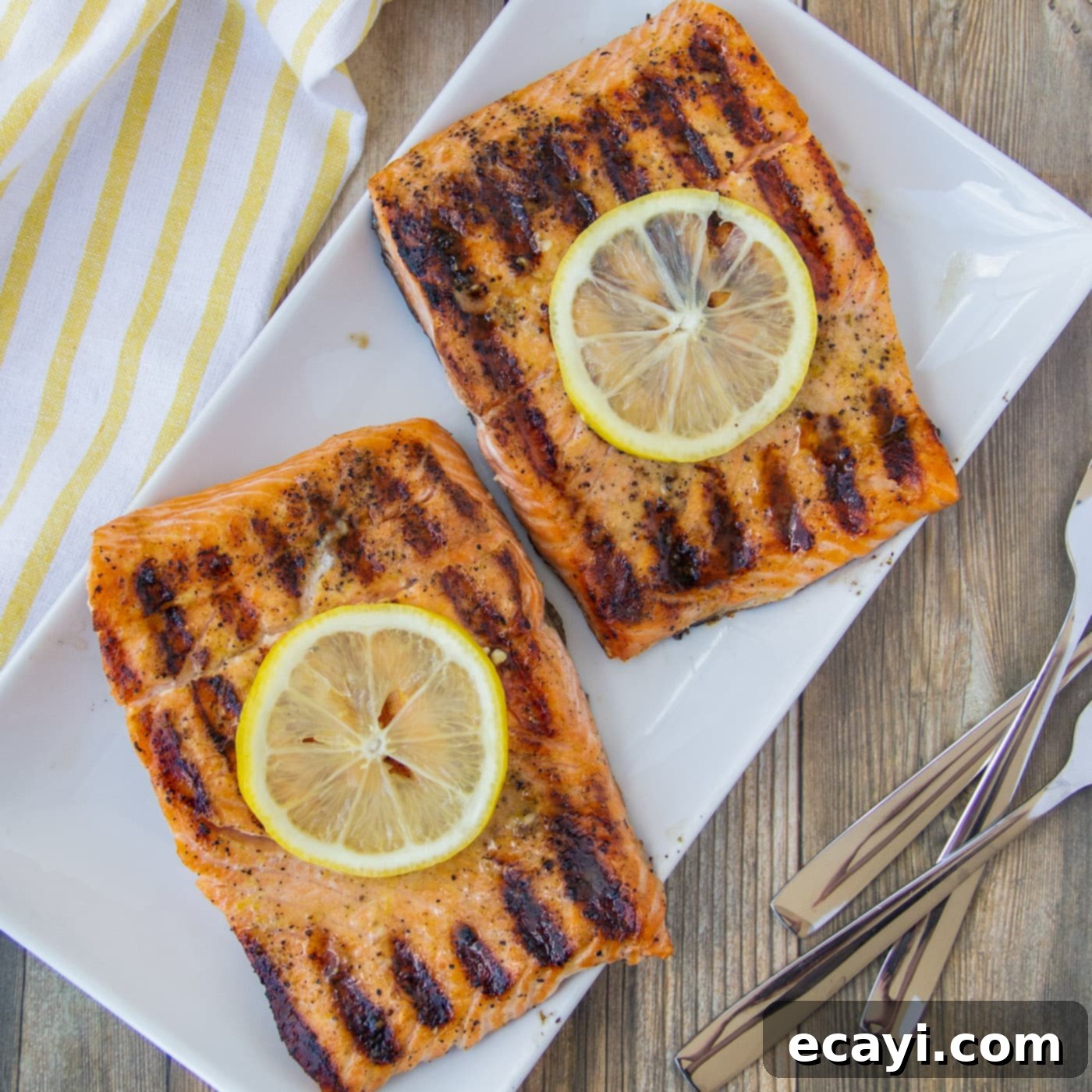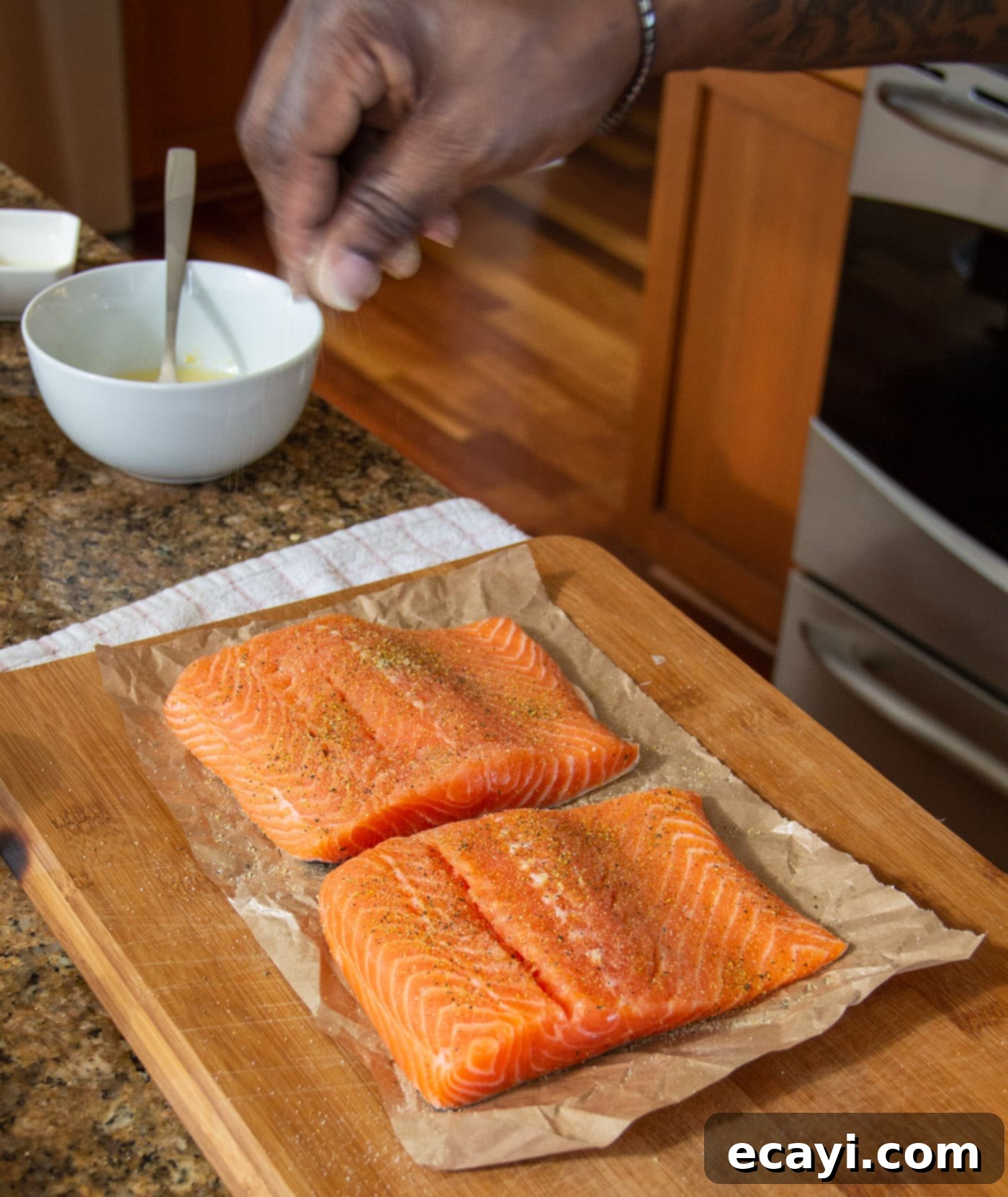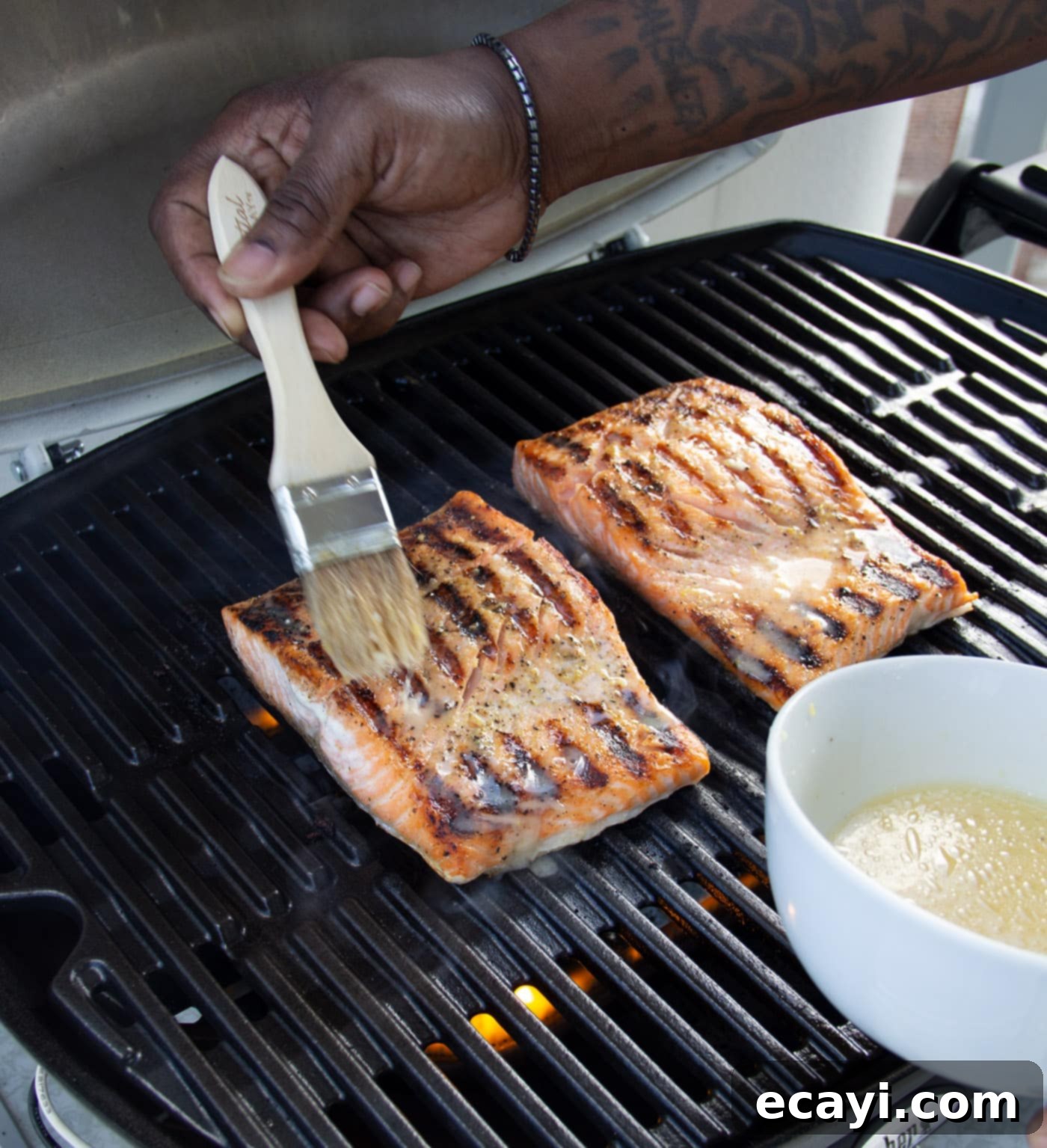Grilled Lemon Garlic Salmon: The Ultimate Flavorful & Easy Dinner Recipe
Experience the vibrant flavors of the sea with our incredible grilled lemon garlic salmon recipe! This dish is not only remarkably quick and easy to prepare, but it also bursts with bright, zippy, and savory notes thanks to a luscious marinade of buttery lemon juice, fresh zest, and aromatic minced garlic. Perfect for a weeknight meal or a special gathering, this salmon promises tender, flaky perfection with every bite.
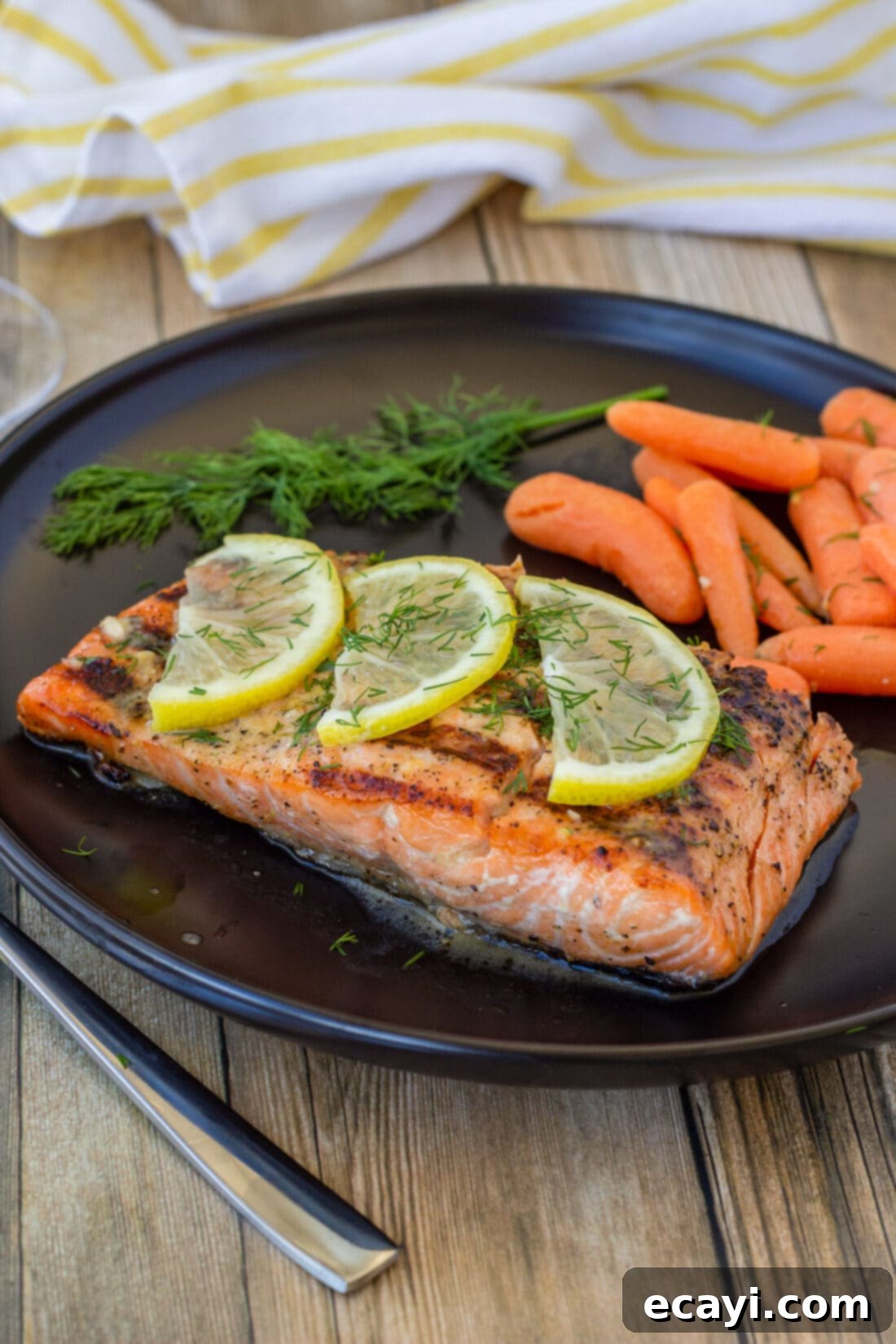
Why This Grilled Lemon Salmon Recipe Is a Must-Try
There’s nothing quite like biting into a piece of perfectly cooked, flaky, and tender salmon, and this classic lemon salmon recipe delivers just that. What makes it truly exceptional is the thoughtful layering of flavors. Each salmon fillet is first seasoned with a robust blend of garlic salt and lemon pepper, creating a foundational savory and zesty base. Then, it’s enveloped in a captivating marinade featuring melted butter for richness, a touch of brown sugar to balance the acidity and encourage a beautiful caramelization, fresh lemon juice for brightness, lemon zest for an intense citrus aroma, and fragrant minced garlic for a deep, savory punch.
Lemon, without a doubt, is the quintessential partner for salmon. Its bold, fresh, and bright acidity beautifully complements the fish’s natural richness, elevating its delicate flavor without overpowering it. This recipe harnesses that synergy, ensuring every forkful is a harmonious blend of citrus and savory notes. Beyond just flavor, grilling offers a fantastic way to cook salmon, imparting a subtle smoky char while keeping the inside incredibly moist and tender. It’s also a quick cooking method, making it ideal for busy evenings when you crave something healthy and delicious without spending hours in the kitchen.
If you’re looking to elevate your dining experience even further, consider serving this grilled masterpiece with our rich lemon cream sauce, which can transform this simple dish into a gourmet delight. Whether you’re a seasoned chef or a beginner in the kitchen, this grilled lemon garlic salmon is designed for success, delivering impressive results with minimal effort.
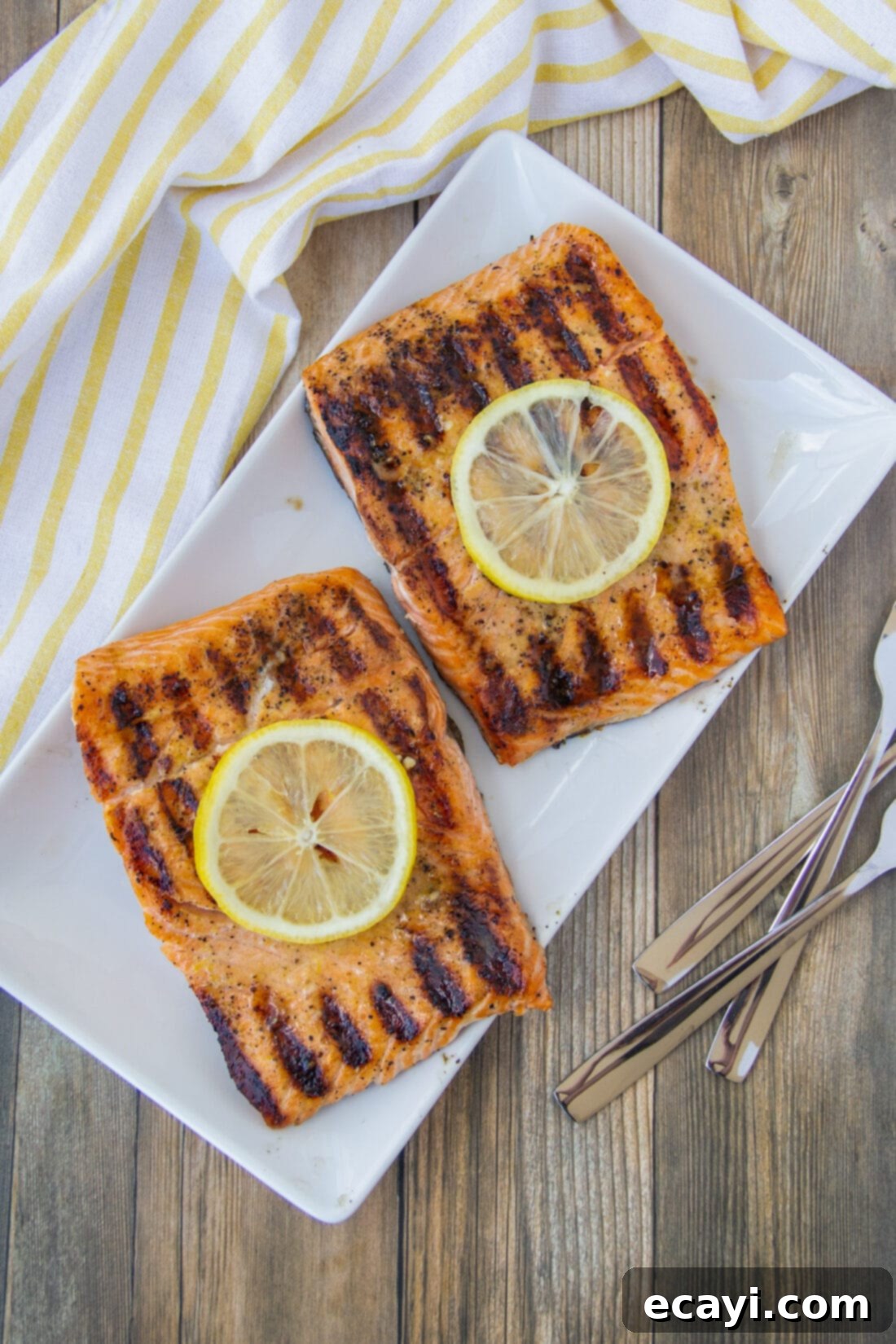
Essential Ingredients for Your Lemon Salmon
Creating truly delicious food often comes down to the quality of your ingredients. For this grilled lemon garlic salmon, a few key components are all you need to achieve outstanding flavor. We encourage you to use the freshest possible produce and good quality salmon for the best results. You’ll find a complete list of all measurements, ingredients, and detailed instructions in the printable recipe card available at the very end of this post.
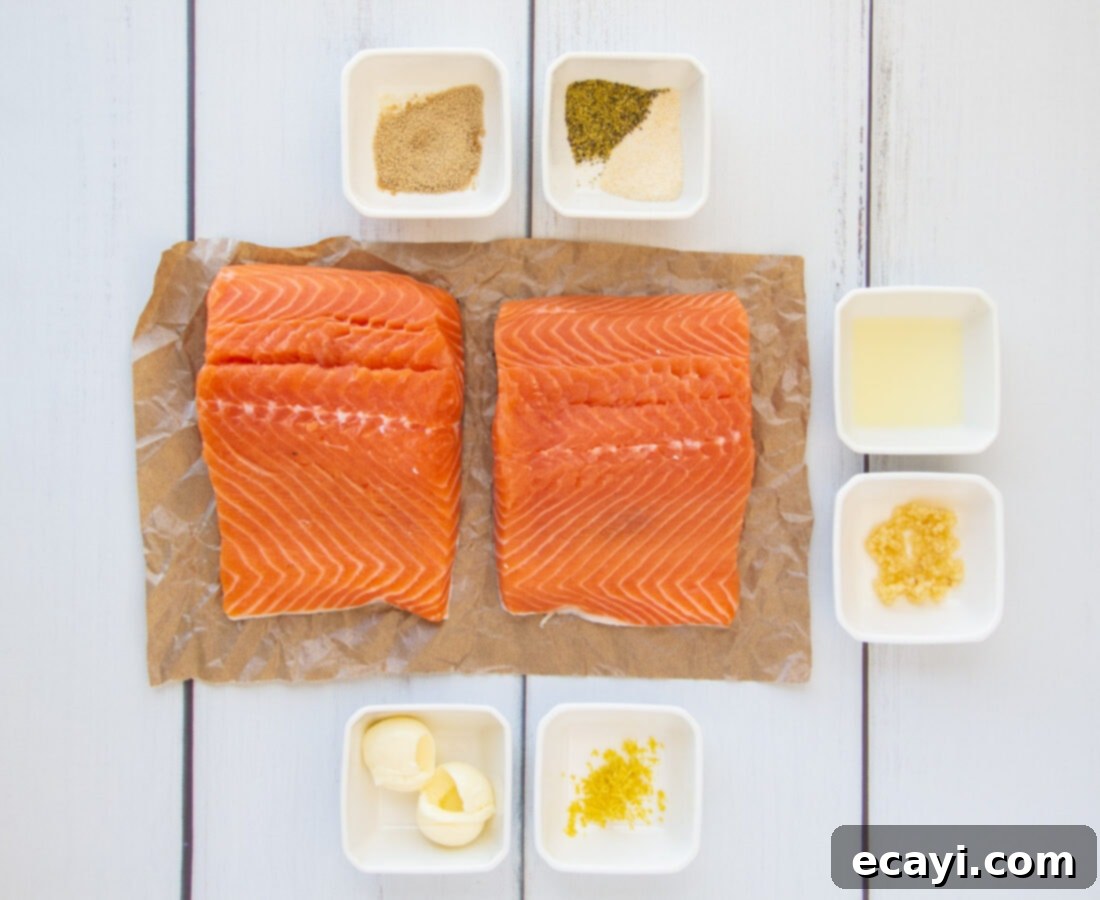
Ingredient Spotlight & Expert Substitution Tips
Understanding each ingredient’s role and knowing how to make smart substitutions can greatly enhance your cooking experience.
SALMON: For this recipe, we opted for two generous center-cut salmon fillets, which are substantial enough to feed four people when portioned correctly. To achieve beautifully clean and individual servings, it’s best to cut the raw salmon in half lengthwise, yielding four distinct fillets before cooking. While it’s certainly possible to cut cooked salmon, it tends to flake and not produce the same neat presentation. When selecting your salmon, look for bright, moist flesh with no discoloration and a fresh, ocean-like scent, not overtly fishy. Both wild-caught and farmed salmon work well, though wild-caught often offers a leaner profile and richer flavor. Skin-on fillets are recommended for grilling as the skin helps protect the delicate flesh from drying out and sticking to the grates.
MARINADE: The marinade is the heart of this dish, infusing the salmon with incredible flavor. Each component plays a crucial role:
- Melted Butter: Provides richness and helps carry the other flavors into the fish. For a dairy-free option, you can use olive oil or a plant-based butter substitute.
- Brown Sugar: This is key to balancing the vibrant acidity of the lemon juice and zest. It also aids in caramelization on the grill, contributing to a beautiful golden crust. If you prefer less sweetness, you can reduce the amount slightly or substitute with a tiny drizzle of maple syrup or honey.
- Fresh Lemon Juice: Absolutely essential for that bright, tangy flavor that defines this dish. We cannot stress enough the importance of using freshly squeezed lemon juice over bottled varieties, as the latter often contains preservatives and lacks the nuanced flavor and aroma of fresh citrus.
- Lemon Zest: The zest contains the concentrated oils of the lemon peel, providing an intense burst of citrus aroma and flavor that lemon juice alone cannot deliver. Don’t skip this for maximum impact!
- Minced Garlic: Adds a savory depth and aromatic warmth. Freshly minced garlic is always best, but good quality pre-minced garlic can be used in a pinch.
- Garlic Salt & Lemon Pepper: These seasonings are your initial flavor base. Garlic salt provides an instant savory kick, while lemon pepper amplifies the citrus notes. Feel free to adjust amounts to your taste, or substitute with individual garlic powder, onion powder, salt, and black pepper.
- Cornstarch: A small amount of cornstarch is used to thicken the reserved marinade into a luscious sauce for basting and serving. This creates a wonderful glaze that clings to the salmon. If you prefer a thinner, lighter sauce, you can omit the cornstarch or use arrowroot powder as an alternative.
Step-by-Step: How to Grill Perfect Lemon Salmon
These step-by-step photos and detailed instructions are here to guide you visually through the process of making this incredibly delicious grilled salmon. For a printer-friendly version of this recipe, complete with precise measurements and comprehensive instructions, please Jump to Recipe at the bottom of this post.
- Season the Salmon: In a small bowl, thoroughly mix together the garlic salt and lemon pepper. Generously sprinkle this seasoning blend over both sides of your salmon fillets. This initial seasoning creates a crucial flavor foundation that permeates the fish as it cooks.

- Prepare the Marinade: In a separate, microwave-safe bowl or small saucepan, melt the butter until completely liquid. Add the brown sugar, fresh lemon juice, lemon zest, and minced garlic to the melted butter. Whisk all these ingredients together until well combined and the brown sugar has dissolved. Spoon a generous amount of this fragrant marinade over your already seasoned salmon fillets, allowing the flavors to begin mingling for a few minutes.
- Marinate the Salmon: Carefully transfer the remaining marinade (that wasn’t spooned over) into a plastic zipper gallon bag or a shallow glass baking dish. Add the seasoned salmon fillets to the bag or dish, ensuring they are fully coated by turning them over a few times. Allow the salmon to marinate in the refrigerator for at least 1 hour. This marination time is crucial for the flavors to deeply penetrate the fish and tenderize it slightly.
- Preheat Your Grill: While the salmon is marinating, preheat your grill to a medium-high temperature, approximately 400°F (200°C). Ensure the grill grates are clean and lightly oiled to prevent sticking.
- Prepare the Basting Sauce: Remove the salmon fillets from the marinade bag/dish and set them aside. Do NOT discard the marinade. Pour all of the used marinade from the bag/dish into a small saucepan. Whisk in the cornstarch until fully dissolved. Heat this mixture over medium-high heat for a few minutes, stirring constantly, just until it warms through and slightly thickens to a glaze-like consistency. This step is important for food safety and to create a perfect basting sauce.
- Grill the Salmon: Place the salmon fillets on the preheated grill with the flesh side down and the skin side facing up. Cook for approximately 15 minutes, allowing the flesh to develop a beautiful sear. Then, carefully turn the fillets over so the skin side is down. Brush generously with the warm, thickened marinade. Continue cooking for another 10 minutes, or until the salmon reaches an internal temperature of 145°F (63°C) at its thickest point. The flesh should be opaque and flake easily with a fork.

Frequently Asked Questions & Expert Tips for Perfect Salmon
To maintain freshness and flavor, store any leftover grilled lemon salmon in an airtight container or tightly wrapped with aluminum foil. Keep it in the refrigerator for up to 3 days. When reheating, gently warm it in a low oven (around 275°F / 135°C) or in a skillet over low heat with a lid to prevent it from drying out. Avoid microwaving if possible, as it can make the fish rubbery.
Starting salmon flesh side down first is an expert tip for grilling. If you begin with the skin side down, the delicate fish flesh will start to cook and become flaky relatively quickly. When you attempt to flip it later, the partially cooked flesh is more likely to fall apart and stick to the grill grates. By starting flesh side down, you allow the flesh to sear and firm up, creating a stable surface that is less prone to breaking when flipped. This method also helps achieve those beautiful grill marks on the presentation side.
Salmon is safely and perfectly cooked when it reaches an internal temperature of 145°F (63°C) as measured by an instant-read thermometer. Always insert the thermometer into the thickest section of the fish, avoiding the bone if present. Visually, the salmon should be opaque throughout and flake easily with a fork. It’s best to remove it from the heat just before it reaches 145°F, as it will continue to cook slightly from residual heat (carryover cooking).
Absolutely! While grilling offers a fantastic smoky flavor, this lemon garlic salmon is equally delicious when baked or pan-fried. To bake, preheat your oven to 400°F (200°C). Place the marinated salmon on a parchment-lined baking sheet and bake for 12-18 minutes, or until it reaches 145°F (63°C). For pan-frying, heat 1-2 tablespoons of olive oil or butter in a large skillet over medium-high heat. Sear the salmon flesh side down for 4-5 minutes, then flip, brush with marinade, and cook skin side down for another 5-7 minutes, or until cooked through.
Preventing salmon from sticking is crucial for perfect grilled fillets. First, ensure your grill grates are spotlessly clean. Any residue can act as an adhesive. Second, preheat your grill thoroughly to the correct temperature (400°F or 200°C in this case). Hot grates create a natural non-stick surface. Third, lightly oil the clean, hot grates just before placing the fish on them. You can use a paper towel dipped in high-smoke-point oil (like canola or grapeseed) held with tongs. Lastly, resist the urge to move the fish too soon; let it sear for the recommended time before attempting to flip.
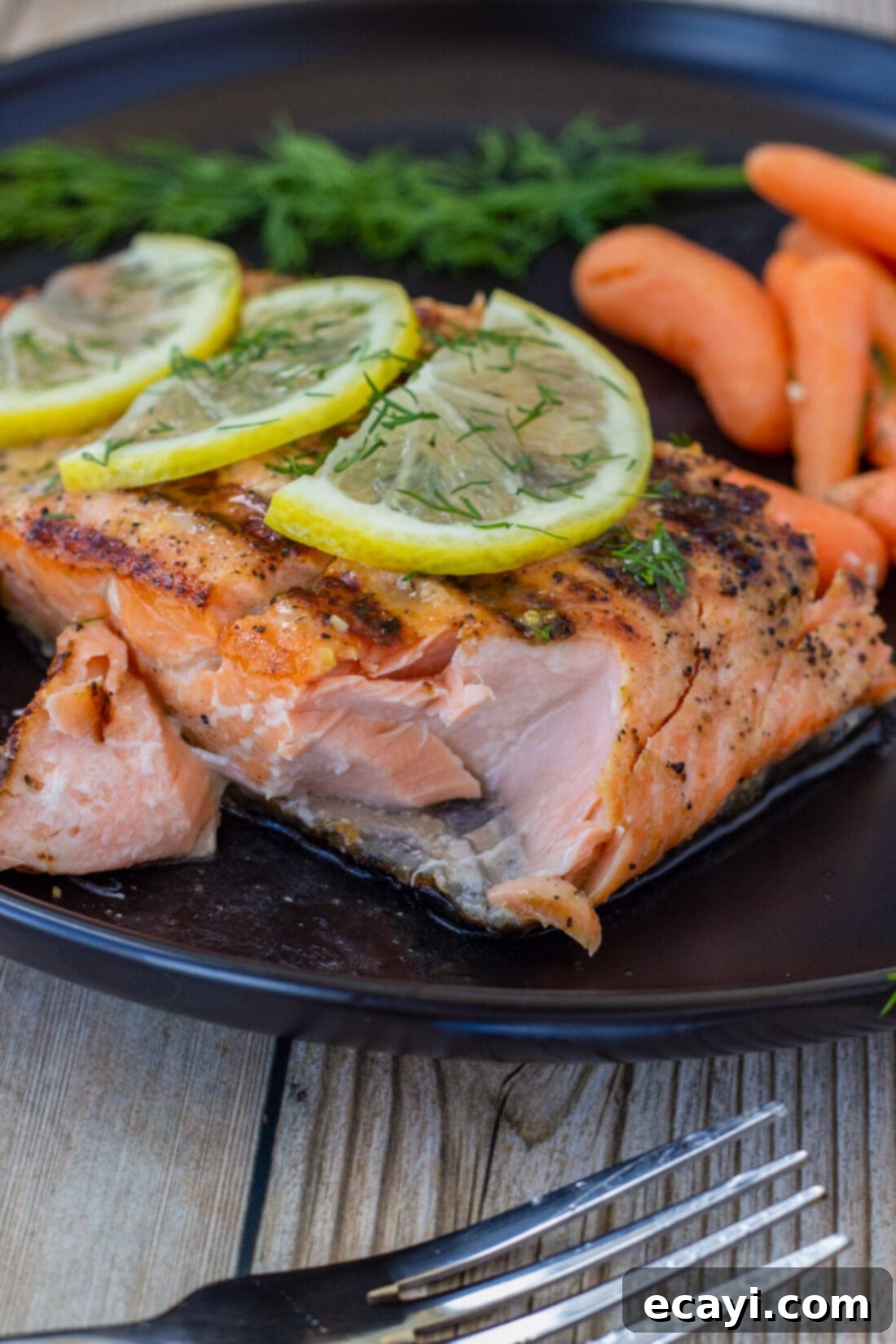
Delicious Serving Suggestions for Lemon Salmon
This garlic lemon salmon is incredibly versatile and pairs beautifully with a wide array of side dishes. For a classic and satisfying meal, serve it alongside fluffy white rice, creamy mashed potatoes, or roasted sweet potatoes. If you’re looking for lighter, healthier options, steamed green beans, tender asparagus, or sweet roasted carrots make excellent complements. A fresh, crisp dinner salad with a light vinaigrette is also a fantastic choice, offering a refreshing contrast to the rich salmon. To round out your meal, consider adding a sprinkle of fresh parsley or dill over the finished salmon for an extra pop of color and herbaceous flavor. A chilled glass of crisp white wine, such as Sauvignon Blanc or Pinot Grigio, would also perfectly complement the bright citrus notes of the dish.
Explore More Delicious Salmon Recipes
If you love salmon as much as we do, you’re in luck! There are countless ways to prepare this incredibly healthy and flavorful fish. Here are some of our other favorite salmon recipes that we think you’ll enjoy:
- Zesty Salmon Tacos
- Classic Grilled Salmon
- Sweet & Savory Maple Soy Salmon
- Smoky Cedar Plank Salmon
- Easy Sheet Pan Salmon Dinner
- Elegant Dijon Lemon Caper Salmon
- Quick Instant Pot Salmon
I adore spending time in the kitchen, experimenting with new flavors, and sharing my culinary discoveries with all of you! Keeping up with new recipes daily can be a challenge, which is why I offer a convenient newsletter delivering every new recipe directly to your inbox. Simply subscribe here and start receiving your free daily dose of deliciousness!
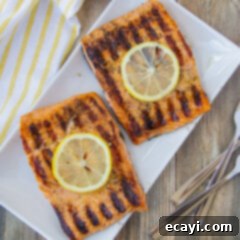
Grilled Lemon Garlic Salmon
IMPORTANT – There are often Frequently Asked Questions within the blog post that you may find helpful. Simply scroll back up to read them!
Print It
Pin It
Rate It
Save ItSaved!
Ingredients
- 1 ½ pounds center cut salmon fillets (about 2 large fillets)
- 1 teaspoon garlic salt
- 1 ½ teaspoons lemon pepper seasoning
- 1 teaspoon light brown sugar
- 2 Tablespoons unsalted butter, melted
- 2 Tablespoons freshly squeezed lemon juice
- 1 teaspoon fresh lemon zest (from one lemon)
- 1 teaspoon minced garlic (about 2 cloves)
- ½ teaspoon cornstarch (optional, for thickening marinade)
Tools You’ll Need
-
Chef’s knife
-
Cutting board
-
Pastry brush
-
Small saucepan
Chef’s Notes & Pro-Tips
- Always begin grilling salmon with the flesh side down. This crucial step allows the delicate flesh to sear and firm up, creating a protective crust. If you start with the skin side down, the fish will begin to cook and become flaky more quickly, making it prone to falling apart and sticking to the grill grates when you attempt to flip it.
- While we used two larger center-cut fillets for this recipe, designed to feed four people, you can easily create individual servings. For the cleanest cuts, it’s best to divide the raw salmon in half, yielding four distinct fillets before you begin the cooking process. Attempting to cut already cooked salmon often results in a less clean line due to its flaky nature.
- Ensure your grill grates are clean and adequately oiled before placing the salmon to prevent sticking. This is a common issue with delicate fish, and a well-prepped grill surface makes all the difference.
- For optimal flavor penetration, aim to marinate the salmon for the full 1 hour. However, avoid marinating for much longer than 2 hours, especially with acidic marinades, as the lemon juice can start to “cook” the fish (similar to ceviche) and alter its texture.
- The basting sauce, made from the reserved marinade and cornstarch, adds an extra layer of flavor and helps create a beautiful, glossy finish on the grilled salmon. Don’t skip gently whisking in the cornstarch and heating it to thicken; this not only enhances the sauce but also makes it safe to consume after contact with raw fish.
Instructions
-
In a small bowl, combine garlic salt and lemon pepper. Sprinkle this mixture generously over both sides of your salmon fillets, ensuring even coverage to build a strong flavor base.
-
Melt the butter. In a separate bowl, whisk together the melted butter with brown sugar, fresh lemon juice, vibrant lemon zest, and minced garlic to create your aromatic marinade. Spoon a portion of this marinade over the seasoned fillets and let them absorb the flavors for a few minutes.
-
Carefully transfer the remaining marinade into a plastic zipper gallon bag or a glass baking dish.
-
Add the salmon fillets to the bag or dish, turning to ensure they are fully coated in the marinade. Allow the salmon to marinate for a minimum of 1 hour in the refrigerator.
-
Preheat your grill to a consistent 400°F (200°C). Ensure the grates are clean and lightly oiled to prevent sticking.
-
Remove the salmon fillets from the marinade and set them aside. Crucially, do not discard the marinade; it will be used for basting.
-
Transfer the reserved marinade from the bag/dish into a small saucepan. Whisk in the cornstarch until thoroughly dissolved. Heat this mixture over medium-high heat for a few minutes, stirring constantly, until it warms through and slightly thickens to a glaze.
-
Place the salmon fillets on the preheated grill, flesh side down and skin side up. Cook for approximately 15 minutes to achieve a beautiful sear. Then, carefully flip the fillets to skin side down and generously brush them with the warmed, thickened marinade. Continue cooking for another 10 minutes, or until the salmon is fully opaque and flakes easily with a fork, reaching an internal temperature of 145°F (63°C).
Nutrition Information
The recipes on this blog are meticulously tested using a conventional gas oven and a gas stovetop. Please be aware that oven performance can vary, especially with age, often leading to inconsistent cooking and baking. We highly recommend using an inexpensive oven thermometer to ensure your oven is consistently reaching the correct temperature. If you choose to use a toaster oven or countertop oven, bear in mind that their heat distribution may differ significantly from a full-sized conventional oven, and you might need to adjust cooking and baking times accordingly. For recipes involving appliances like pressure cookers, air fryers, or slow cookers, specific links to the models we use are provided within their respective recipe sections. When it comes to baking recipes that list measurements by weight, please note that using volume (cups) instead may lead to different results, and we cannot guarantee success with such method variations.
